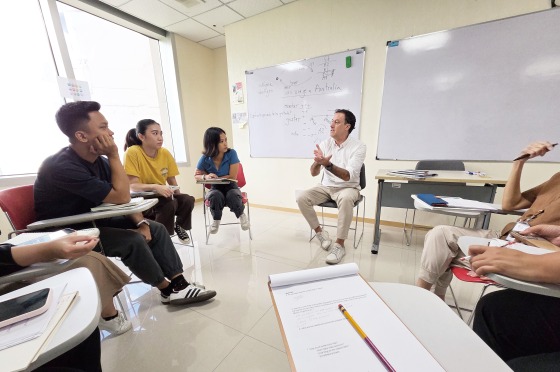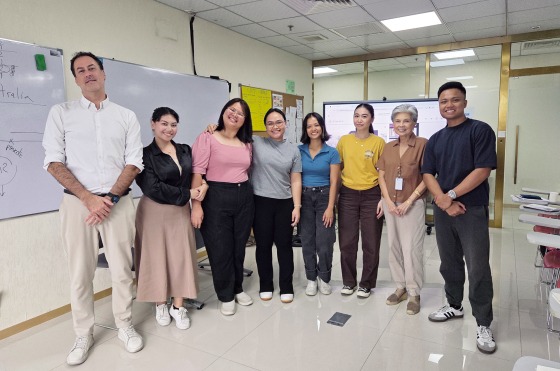
スペイン政府が設立した語学学校
対話形式で学び、会話力を磨く
約20カ国で話され、世界で6億人の話者がいるとされるスペイン語。英語などとともに国連公用語でもあるスペイン語教育の振興およびスペイン語圏の文化の普及を目的に、スペイン政府によって設立されたのがインスティトゥト・セルバンテスです。世界40カ国70カ所を拠点に展開しており、マニラ首都圏ではマカティにあります。
インスティトゥト・セルバンテス・マニラにはスペイン語コースが設けられており、通学またはオンライン、そして入学時に受講頻度を週1回、2回、4回から選べます。1クラスは15人まで。授業は一方通行ではなく、対話式でコミュニケーションを重視。アルベルト・ヒネステ・ヨンバルト先生の初心者向けA2クラスではスペイン語をメインに話しつつ、詳しい説明は英語で行われます。受講生が臆せずに話せる雰囲気のクラスです。
インスティトゥト・セルバンテス・マニラには、DELEスペイン語検定試験対策コースや外国人向けタガログ語コースもあります。
歴史的にもフィリピンとスペインは深い関係があり、タガログ語とスペイン語には共通の語彙が多くあります。フィリピンで英語とスペイン語の習得を目指してみてはいかがでしょう?

スペイン・バルセロナ出身のアルベルト・ジネステ・ロンバート先生は心理学者であり言語学者。スペイン語のほか、フランス語、アラビア語なども堪能。

アリーさん Aly Pasay City, Metro Manila Photographer specializing in street and documentary photography
スペイン語を学び始めたのは、父の影響です。曽祖父がスペイン人で、父は自分たちのルーツであるスペイン、そしてスペイン語にとても関心を持っていました。父と一緒にスペイン語を学びはじめたのは3、4歳のころ。基本的なことや歌を教えてもらううちに、スペインの言葉と文化に魅せられました。
そんな中でスぺイン語を学校で学んでみたい、スぺイン語を話す機会がほしいと思い、昨年インスティトゥト・セルバンテス・マニラへ入学し、スペイン人の先生から話す、聞く、読む、書くといった技能を総合的に学ぶことができました。
タガログ語話者にとっては、スペイン語は似ているので、親しみやすいと思います。例えば、スペイン語でスプーンはcuchara、タガログ語ではkutsara、一方、似たような単語でも意味が異なることがあって、スペイン語でderechaは「右」ですが、タガログ語でdirechoは「まっすぐ」といった具合。
スペイン語ができれば、より多くの人とつながることができるようになると思いますし、新しい言語を話すことで違うキャラクターの自分になって、新しい世界に入って行くような感覚になるんです。
2年前に親戚を訪ねてスぺインに行きました。いつか同じスペイン語圏のメキシコに行きたいと思っています。
Spanish Classes with Interaction and Conversation
Instituto Cervantes was created by the Spanish government in 1991 with the goal of teaching the Spanish language and co-official languages to the world, along with promoting cultures from Spain and other Spanish-speaking countries. Their Metro Manila branch is in Makati, and they also have a library in Intramuros. Instituto Cervantes follows the guidelines of the Common European Framework of Reference for Languages: Learning, Teaching, Assessment (CEFR), with a strong focus on an action-oriented methodology.
Their general courses have a total of 60 hours with a maximum of 15 students per class. Classes can be done once, twice, or four times a week, either fully onsite or online. Other courses include those for children, DELE preparation classes, other co-official languages, Tagalog for foreigners, and more.
Alberto Gineste Llombart is the Head of Studies of Instituto Cervantes Manila and has been teaching Spanish for 20 years around Europe, Africa, America, and Asia. He is a Psychologist and Linguist and can speak several languages including Spanish, French, Arabic, and more. His hometown is Barcelona, but he has lived in other countries throughout his life and now resides in the Philippines.
Classes with Mr. Alberto and other instructors in the school are interactive and communicative because they make learning languages more effective. During his beginner A2 class, he conversed with his students frequently using Spanish, and then used English for further guidance. His classes have a positive atmosphere where the students are comfortable speaking and helping each other on each topic.
Learning Spanish is beneficial because there are over 600 million people and several countries that speak the language. It opens more opportunities for work in and out of the country, lets you connect with more people, and just like learning any other language, it helps exercise the brain.
For Filipinos, the Spanish language is closely tied to their own culture, history, and heritage. Many Spanish words are already in several Filipino languages. This gives an advantage when it comes to pronunciation and vocabulary, but for some topics in grammar, it can be more difficult to grasp.
Interview with a Spanish Learner
Aly from Pasay City, Metro Manila Photographer specializing in street and documentary photography
It is because of my father that I have been driven to learn Spanish. My great-grandfather was Spanish and my father is very interested in our roots and the language. I started learning Spanish with my father when I was three or four years old. I was taught basic words and songs. Ever since I was introduced to the Spanish language and culture, I have been drawn to learning more about it and exploring Spanish-speaking countries, particularly Spain.
I was curious about how the Spanish language is taught at school and I wanted more opportunities to speak it, so last year I enrolled in Instituto Cervantes Manila, where I was able to learn integrated skills such as speaking, listening, reading, and writing from a Spanish teacher.
Tagalog speakers become easily familiar with Spanish as there are similarities between them. For example, the word “spoon” is cuchara in Spanish and kutsara in Tagalog. Similar words can also have different meanings such as derecha in Spanish is “right,” while direcho in Tagalog is “straight”.
Speaking Spanish allows me to connect with more people and makes me feel like a different character, as if I were entering a new world.
I went to Spain to explore, work, and visit some of my relatives. One day, I would like to go to Mexico, which is also a Spanish-speaking country.

Instituto Cervantes Manila
Address: 11/F, The Enterprise Center, Tower 1, Ayala Avenue corner Paseo de Roxas,
Makati City, Metro Manila
















